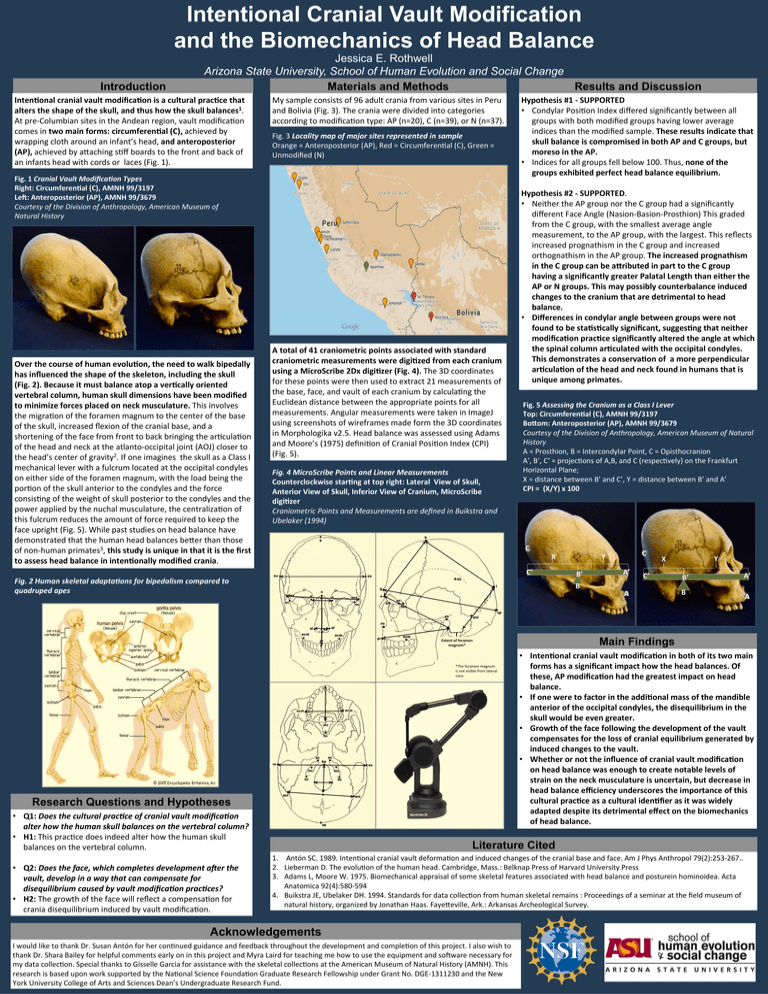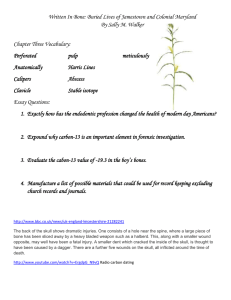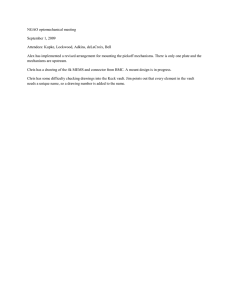Intentional Cranial Vault Modification and the Biomechanics of Head
advertisement

Intentional Cranial Vault Modification and the Biomechanics of Head Balance Introduction Jessica E. Rothwell Arizona State University, School of Human Evolution and Social Change Results and Discussion Materials and Methods Inten%onal cranial vault modifica%on is a cultural prac%ce that alters the shape of the skull, and thus how the skull balances1. At pre-­‐Columbian sites in the Andean region, vault modifica:on comes in two main forms: circumferen%al (C), achieved by wrapping cloth around an infant’s head, and anteroposterior (AP), achieved by a?aching s:ff boards to the front and back of an infants head with cords or laces (Fig. 1). My sample consists of 96 adult crania from various sites in Peru and Bolivia (Fig. 3). The crania were divided into categories according to modifica:on type: AP (n=20), C (n=39), or N (n=37). Fig. 3 Locality map of major sites represented in sample Orange = Anteroposterior (AP), Red = Circumferen:al (C), Green = Unmodified (N) Fig. 1 Cranial Vault Modifica0on Types Right: Circumferen%al (C), AMNH 99/3197 LeX: Anteroposterior (AP), AMNH 99/3679 Courtesy of the Division of Anthropology, American Museum of Natural History Over the course of human evolu%on, the need to walk bipedally has influenced the shape of the skeleton, including the skull (Fig. 2). Because it must balance atop a ver%cally oriented vertebral column, human skull dimensions have been modified to minimize forces placed on neck musculature. This involves the migra:on of the foramen magnum to the center of the base of the skull, increased flexion of the cranial base, and a shortening of the face from front to back bringing the ar:cula:on of the head and neck at the atlanto-­‐occipital joint (AOJ) closer to the head’s center of gravity2. If one imagines the skull as a Class I mechanical lever with a fulcrum located at the occipital condyles on either side of the foramen magnum, with the load being the por:on of the skull anterior to the condyles and the force consis:ng of the weight of skull posterior to the condyles and the power applied by the nuchal musculature, the centraliza:on of this fulcrum reduces the amount of force required to keep the face upright (Fig. 5). While past studies on head balance have demonstrated that the human head balances be?er than those of non-­‐human primates3, this study is unique in that it is the first to assess head balance in inten%onally modified crania. A total of 41 craniometric points associated with standard craniometric measurements were digi%zed from each cranium using a MicroScribe 2Dx digi%zer (Fig. 4). The 3D coordinates for these points were then used to extract 21 measurements of the base, face, and vault of each cranium by calcula:ng the Euclidean distance between the appropriate points for all measurements. Angular measurements were taken in ImageJ using screenshots of wireframes made form the 3D coordinates in Morphologika v2.5. Head balance was assessed using Adams and Moore’s (1975) defini:on of Cranial Posi:on Index (CPI) (Fig. 5). Fig. 4 MicroScribe Points and Linear Measurements Counterclockwise star%ng at top right: Lateral View of Skull, Anterior View of Skull, Inferior View of Cranium, MicroScribe digi%zer Craniometric Points and Measurements are defined in Buikstra and Ubelaker (1994) Hypothesis #1 -­‐ SUPPORTED • Condylar Posi:on Index differed significantly between all groups with both modified groups having lower average indices than the modified sample. These results indicate that skull balance is compromised in both AP and C groups, but moreso in the AP. • Indices for all groups fell below 100. Thus, none of the groups exhibited perfect head balance equilibrium. Hypothesis #2 -­‐ SUPPORTED. • Neither the AP group nor the C group had a significantly different Face Angle (Nasion-­‐Basion-­‐Prosthion) This graded from the C group, with the smallest average angle measurement, to the AP group, with the largest. This reflects increased prognathism in the C group and increased orthognathism in the AP group. The increased prognathism in the C group can be a\ributed in part to the C group having a significantly greater Palatal Length than either the AP or N groups. This may possibly counterbalance induced changes to the cranium that are detrimental to head balance. • Differences in condylar angle between groups were not found to be sta%s%cally significant, sugges%ng that neither modifica%on prac%ce significantly altered the angle at which the spinal column ar%culated with the occipital condyles. This demonstrates a conserva%on of a more perpendicular ar%cula%on of the head and neck found in humans that is unique among primates. Fig. 5 Assessing the Cranium as a Class I Lever Top: Circumferen%al (C), AMNH 99/3197 Bo\om: Anteroposterior (AP), AMNH 99/3679 Courtesy of the Division of Anthropology, American Museum of Natural History A = Prosthion, B = Intercondylar Point, C = Opisthocranion A’, B’, C‘ = projec:ons of A,B, and C (respec:vely) on the Frankfurt Horizontal Plane; X = distance between B’ and C’, Y = distance between B’ and A’ CPI = (X/Y) x 100 C C’ Fig. 2 Human skeletal adapta0ons for bipedalism compared to quadruped apes Research Questions and Hypotheses A’ Y X C’ A B’ B A’ A Main Findings Extent of foramen magnum* • Q1: Does the cultural prac0ce of cranial vault modifica0on alter how the human skull balances on the vertebral column? • H1: This prac:ce does indeed alter how the human skull balances on the vertebral column. • Q2: Does the face, which completes development aDer the vault, develop in a way that can compensate for disequilibrium caused by vault modifica0on prac0ces? • H2: The growth of the face will reflect a compensa:on for crania disequilibrium induced by vault modifica:on. B’ B *The foramen magnum is not visible from lateral view. C Y X • Inten%onal cranial vault modifica%on in both of its two main forms has a significant impact how the head balances. Of these, AP modifica%on had the greatest impact on head balance. • If one were to factor in the addi%onal mass of the mandible anterior of the occipital condyles, the disequilibrium in the skull would be even greater. • Growth of the face following the development of the vault compensates for the loss of cranial equilibrium generated by induced changes to the vault. • Whether or not the influence of cranial vault modifica%on on head balance was enough to create notable levels of strain on the neck musculature is uncertain, but decrease in head balance efficiency underscores the importance of this cultural prac%ce as a cultural iden%fier as it was widely adapted despite its detrimental effect on the biomechanics of head balance. Literature Cited 1. Antón SC. 1989. Inten:onal cranial vault deforma:on and induced changes of the cranial base and face. Am J Phys Anthropol 79(2):253-­‐267.. 2. Lieberman D. The evolu:on of the human head. Cambridge, Mass.: Belknap Press of Harvard University Press 3. Adams L, Moore W. 1975. Biomechanical appraisal of some skeletal features associated with head balance and posturein hominoidea. Acta Anatomica 92(4):580-­‐594 4. Buikstra JE, Ubelaker DH. 1994. Standards for data collec:on from human skeletal remains : Proceedings of a seminar at the field museum of natural history, organized by Jonathan Haas. Faye?eville, Ark.: Arkansas Archeological Survey. Acknowledgements I would like to thank Dr. Susan Antón for her con:nued guidance and feedback throughout the development and comple:on of this project. I also wish to thank Dr. Shara Bailey for helpful comments early on in this project and Myra Laird for teaching me how to use the equipment and soaware necessary for my data collec:on. Special thanks to Gisselle Garcia for assistance with the skeletal collec:ons at the American Museum of Natural History (AMNH). This research is based upon work supported by the Na:onal Science Founda:on Graduate Research Fellowship under Grant No. DGE-­‐1311230 and the New York University College of Arts and Sciences Dean’s Undergraduate Research Fund.

